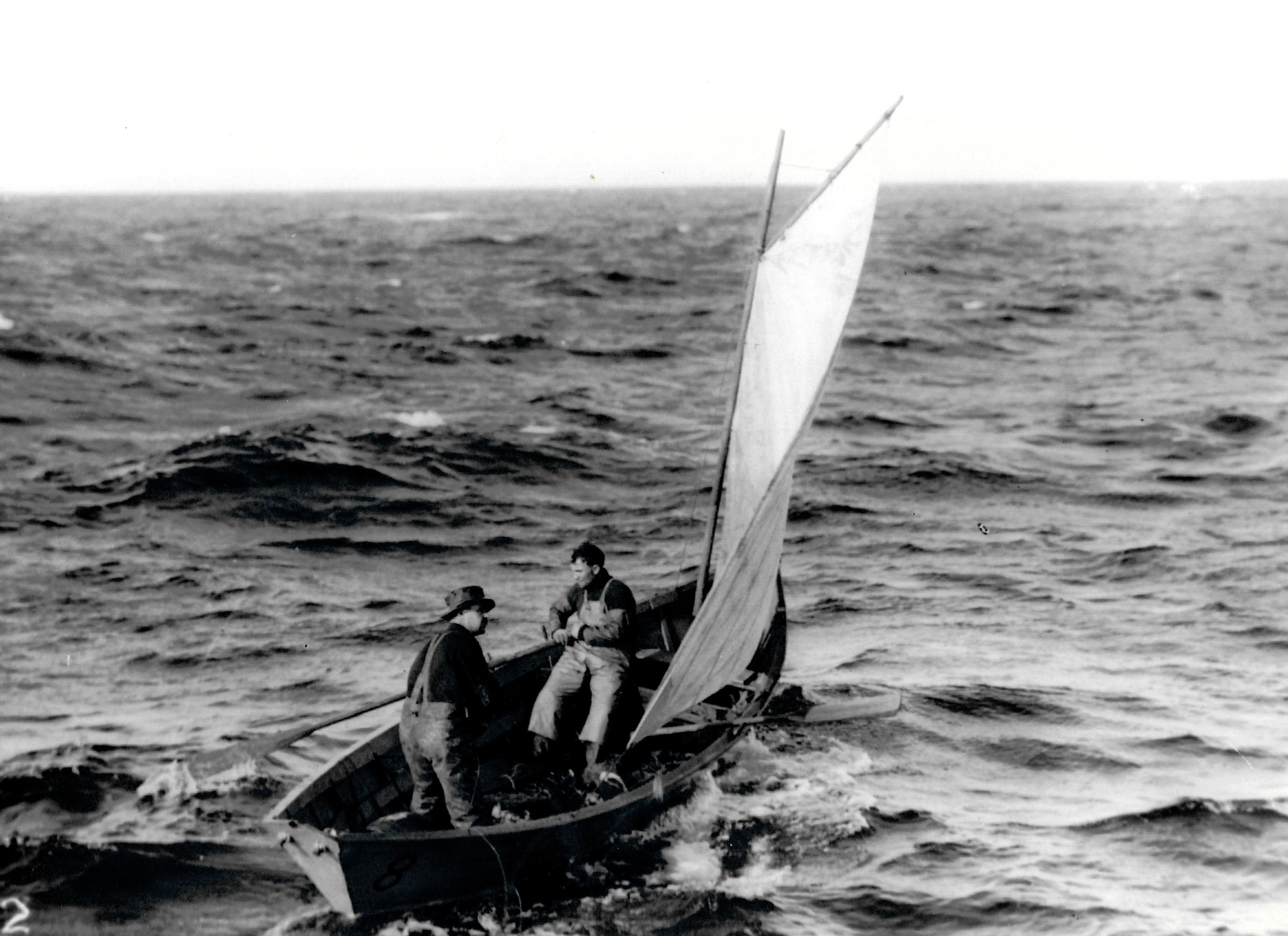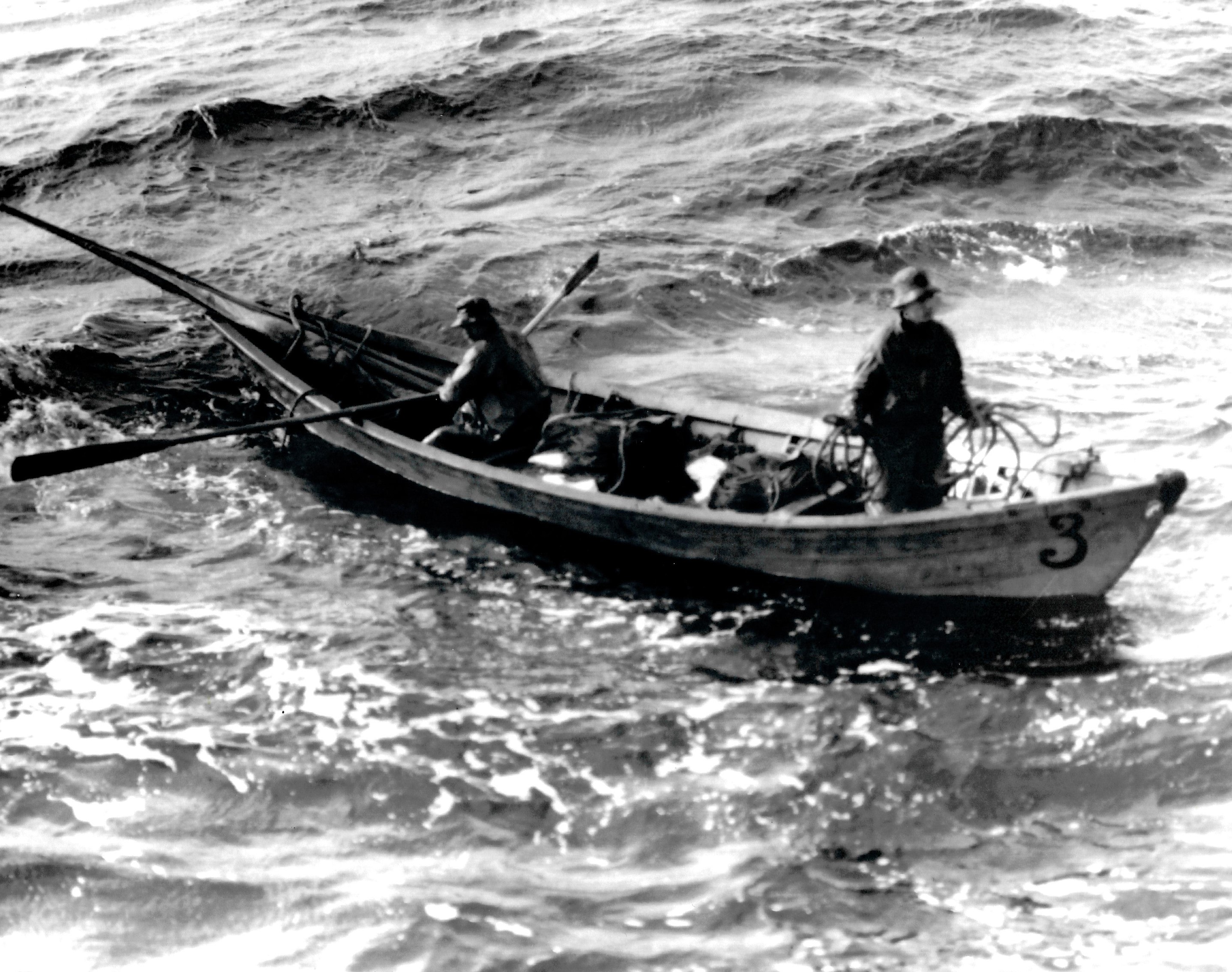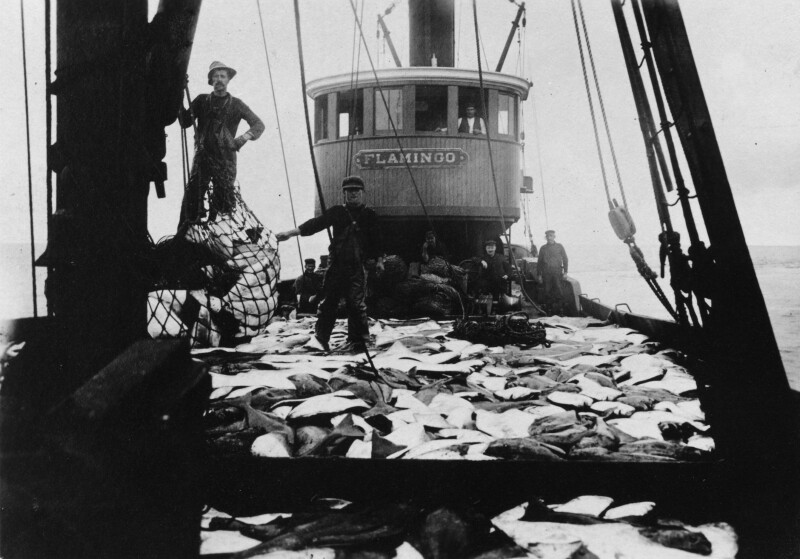Article two of a series written by Arni Thomson- History of the Fishing Vessel Owners Association (FVOA), Seattle, WA, Activities from 1914 – 2024.
NEFCO moved carefully on the new venture, and it was not until October 1890 that the Directors of the Company officially discussed the possibility of engaging in the West Coast fishery. Decisive action was finally taken by the Directors in January, 1894, Mr. Grier Starratt was hired to represent the Company on the West Coast and a committee was sent to investigate. Following the committee’s return to Boston, they recommended the establishment of a shipping station in British Columbia, a receiving station in Northern British Columbia, and a boat for transporting the fish from the receiving station to the shipping station. The necessary steps were taken, including chartering of the Steamer Capilano from the Union Steamship Company in Vancouver for the 1894-1895 fishing season.
The selection of Vancouver, B.C., as a base of operations was influenced by the attitude of the newly completed transcontinental railroads then serving the Pacific Northwest. NEFCO wanted to use refrigerator cars similar to those which were beginning to be used out of Chicago by the meat packers and to attach them to passenger trains to expedite their delivery over the 3,000 mile, seven day haul. The Northern Pacific Railway refused to permit refrigerator cars with fish to be attached to their passenger trains. They also considered the handling of fresh fish over such a great distance to be impractical. The Canadian Pacific Railway, however, was willing to carry the cars on passenger trains and to co-operate to the extent of refunding transportation charges in case of failure, if NEFCO would not make a claim for any loss of fish. Vancouver, the Western Terminal of the Canadian Pacific Railway, was thus selected as the operations base for NEFCO to start Pacific Coast operations.
The new venture was successful from the outset. By October 16, 1894, three carloads of fresh halibut, packed in ice in 500-pound boxes, had already been received and sold, having arrived in good condition. Three more cars were en route, with more to arrive a week later. For the second season, 1895-96, another steamer was chartered,, and the catch came to 1.5 million pounds for the season.
“In those days,” stated Grier Starratt, “the grounds had too many halibut upon them---the fish were eating one another. We caught big halibut having 2, 3, or 4 small ones inside their stomachs.” He described one benthic valley as having its sides “simply solid with halibut.”
Three steamers were used to transport halibut until the 1898-1899 season when the steamer New England built in 1897-1898 especially for the halibut fishing in the North Pacific, began operations. With this steamer, NEFCO pioneered a new and distinct type of vessel. Due to the long voyage around Cape Horn up to the Pacific Northwest, the new vessel did not begin fishing operations until the fall of 1898. Following the immediate success of the New England, NEFCO commissioned construction of the Manhattan and Kingfisher. They were built in Philadelphia and San Francisco in 1902 and 1904.
In the early nineteen hundreds NEFCO began to handle frozen halibut and also fresh and frozen salmon. These additional activities, along with greater volume, necessitated shore plants. The Canadian Pacific Railroad leased a dock and building to NEFCO in 1904 especially built for the Company’s use.
In 1906, NEFCO conceived the idea of seeking a supply of halibut for freezing in Alaska, and in 1907, the construction of a cold storage plant in Ketchikan was begun. The Company was again criticized for this futuristic move, but the Ketchikan plant , the first of its kind far removed from railheads, soon justified its existence.
In 1908, NEFCO purchased the Northwestern Fisheries Company of Boston, which included an interest in the Doty Fish Co. (later wholly owned). With this purchase the Company secured the services of Mr. Alvah L. Hager who was managing the Northwestern Fisheries Company.
In October 1909 NEFCO acquired the Canadian Fishing company, Limited (Canfisco) followed by Atlin Fisheries Limited in 1912, the latter owned by the writer’s grandfather Mr. M.P. McCaffery, a Prince Rupert pioneer and Mayor during the critical World War I years of 1916 and 1917. With the purchase of Canfisco, NEFCO gained six more steamers.
Hager was then sent to Vancouver, British Columbia, to take over all of NEFCO’s West Coast operations as general Western Manager and to also be General Manager of the Canadian Fishing Company, Limited.
It had become evident to Mr. Hager there was a need for a Canadian Company to handle Canadian business in both fresh and frozen fish. Following the purchase of Canfisco, the activities of NEFCO in fresh and frozen salmon expanded continuously. In 1910, a large freezing, cold storage and ice-making plant was built in Vancouver B.C.
He is known as the “father of the Halibut Treaty” which was consummated in 1923. The Treaty has been widely recognized as an outstanding success in the rehabilitation of the fishery and this work is still considered a model of international fisheries conservation. Consummation of the International Salmon Treaty between Canada and the U.S. in 1937 was primarily due to the untiring efforts of Mr. Hager over a long period of years.
In 1918, the fiftieth anniversary of the founding of the Company, halibut, fresh and frozen, was still the dominant factor in the company’s business. The Company was founded to produce and market halibut.
The Steamer Era
Almost from the time the commercial fishery began in 1888, it became obvious that if the fishery was to achieve stature and become profitable, it would require newly constructed vessels powered by coal or internal combustion engines. The sailing vessels of the east coast offshore fishery could not negotiate the fjords nor the rocky harbors of the Northwest Pacific Coast with their strong tidal flows. Auxiliary power was also required to enable winter fishing when the East Coast markets for Pacific halibut were the most favorable. Fast and dependable vessels were needed to speed the fish from the grounds to rail points in Seattle, Tacoma, and Vancouver to offset the effects on quality of the long transcontinental rail haul to Atlantic Coast markets, which took seven days.


The first vessels employed in the steamer fishery were vessels converted from other uses, but they were a good proving-ground for developing effective techniques and fishing strategies for steamer halibut fishing, followed by the schooner period of building and fishing. The first steamer custom built for the Pacific halibut fishery, as noted, was the S.S. New England. This vessel and the steamer era were launched in 1898. The vessel was tremendously successful throughout most of its 30 year career in the halibut fishery. It was 121.8 feet in length, 24 feet wide, 12 feet deep, 230 gross and 70 net tons. It could accommodate 12 dories and a crew of 37, including 24 fishermen and was able to carry 220,000 pounds of iced halibut (Bell, p. 40). “In its first year of halibut fishing, the New England fished off Rose Spit and in Hecate Strait, off the coast of British Columbia. The vessel carried 10 two-man dories the first two seasons. Each dory was provided with 10 tubs or skates each of 10 lines of 50 fathoms of #32 tarred cotton ground line with ganglings spaced 9 feet apart. In the first two or three years of operations, the New England on the average, fished fewer than 100 such units of gear or skates of about 310 hooks each per trip. Indicative of the density of the more or less primeval stocks, catching 1,000 pounds per skate was regarded as only “fair” fishing and under such conditions the vessel would usually change grounds.” Dories could carry 2,000 pounds of halibut, and on heavy fishing, could make up to 5 trips in a day.
Bell recounted one of the most significant catches of halibut that came out of the Hecate Straight area on August 31, 1904 on the S.S. New England under the legendary Captain Absalom Freeman, fishing 12 dories 10 miles Southwest of Dundas Island caught 188,000 pounds of halibut, the largest single-day catch on record during the 90 year history of the Pacific halibut fishery.
Bell also notes the contribution of another important New England pioneer, Captain Hanson Benjamin Joyce. Joyce was a native of Swan Island, Maine, and had been the “high liner” in the New England vessel fisheries in 1874, 1876, 1877, 1879, 1880, 1884 and 1887. He formed a team with Captain Freeman that assured NEFCO’s success in the development of the halibut fishery. He was involved in the design of the S.S.New England and he introduced many innovations in dory fishing. He also made production records during the years he was captain of the S.S. Kingfisher.
Most of the steamers were large with big crews, 14 to 37 men compared to present-day standards for halibut fishing vessels. They were owned and operated by fishing companies that engaged in the distribution of halibut and quite often other fishery products. The steamers usually fished with 8 to 14 dories, depending on the size of the vessel.
With dories, fishermen were able to deploy large amounts of gear on the heavy concentrations of fish that prevailed in the early years. The vessels had hold capacities of 150,000 to 300,000 pounds. By 1913, steamers began experimenting with ”setting chutes” and “gurdies” and “rollers” for hauling gear that soon began replacing dories, so setting and hauling the gear was done from the deck of the steamers. Eventually, the gurdy replaced the hazardous two-man dories.
During the early to middle years most of the steamers could catch between 3 to 3.5 million pounds of halibut annually. The U.S. fleet numbered 11 and the Canadian fleet 12 vessels that could be be classed as halibut steamers with meaningful production records. The steamer period was productive, as noted, until about 1920, when stocks began to decline and operation costs for the large vessels increased. The maximum number of steamers employed in one year was 16 in 1914. During World War I, it declined and by 1918 there were 10 vessels. By 1925, there was only one steamer fishing, the S.S. New England vessel. It operated from 1898 through 1930 and left a total catch record of about 40 million pounds of halibut, a record that may not be exceeded by any setline fishing vessel.
It is worth referencing the infamous “Grimsby Trawlers” from Hull, England, that Canfisco brought to Prince Rupert about 1913. According to the story, they were among the first to install “gurdies” and “shutes” for setting and hauling from the deck of the steamers. The three converted trawlers began 21-25 day trips to the Bering Sea as early as 1913, which ended in 1920 over a strike when Canfisco would not meet the demands. Tying up the steamers was an indication that halibut stocks were already being depleted on the Southern grounds.
There were a number of developments that led to the decline and liquidation of the steamer fleets. The initial advantage of the large steamer being able to deploy large amounts of gear on heavy concentrations of fish had largely disappeared with the decline in stocks.
The Halibut Schooner Era
The manpower requirement became acute during World War I, particularly as it affected the availability and payment of nonfishing crew members. Fishing companies were diverting more of their energies and capital to building up their investment in the more lucrative salmon industry. It had also become evident that halibut fishing could be done more efficiently and economically by owner-operated vessels.






